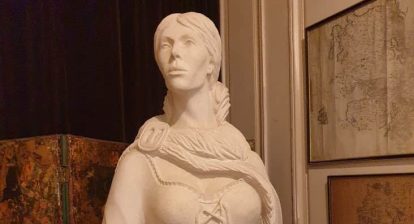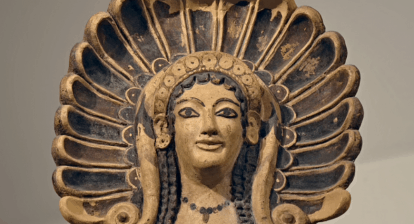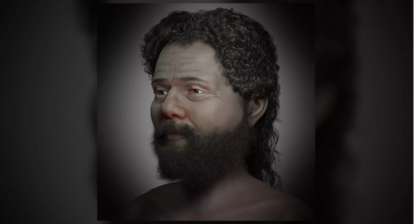Video on mother goddesses and fertility cults
Blogpost/Transcript
In September of 2008, a team of archaeologists working in the Hohle Fels cave in Germany uncovered a remarkable find: a figurine made of mammoth ivory dated to between 40,000 and 35,000 years ago. Now known as the Venus of Hohle Fels, this figurine is the oldest known representation of the human form. The exaggerated anatomy and massive breasts are a powerful depiction of being female — symbolizing the fertility goddess’ characteristics of sex and reproduction.
Many such figurines have been found across the globe, generally interpreted as being mother goddesses — considered magical because of their ability to create life. The mythology of the mother goddess places them as part of a divine pair with a male consort — who could sometimes also be human.
While no one can definitely say what the Hohle Fels Venus actually represented to people at that time, and her symbolism comes entirely from anthropologists’ interpretations, what we do know is that such figurines continued to be created throughout history.
Some experts believe that women were at the top of societies — from perhaps as far back as the late Stone Age — the period to which the Hohle Fels Venus belongs, as does the Venus of Willendorf, a 30,000-year-old statuette discovered in 1908 in Austria. Alternatively, perhaps humans considered fertility an important aspect of a successful community.
We fast-forward to the start of the Neolithic period about 12,000 to 10,000 years ago and the advent of agriculture. Prior to this, humans were still hunter-gatherers and women were the original seed-gatherers. Perhaps women were behind the early development of agriculture when they started selecting the best seeds for the next year’s crop. It is not hard to imagine that this expertise combined with their ability to give birth and to bleed without dying, could have resulted in their association with a mother goddess.
(Another 7,800-year-old female figurine found in Türkiye)
Sometimes the mother goddess was a snake, sometimes she was the Moon, among a variety of other representations, each signifying a cycle of birth, death and regeneration. Around 12,000 years ago, some societies reached the cusp of moving from a nomadic lifestyle to semi settled proto-cities — though they still got some of their food by hunting. Several such archaeological sites exist around the Levant and Turkey. One of them is Catalhoyuk, a Neolithic proto-city in Turkey, settled more than 9,000 years ago. Here were uncovered two 8,000-year-old female figurines, both corpulent and both thought to be either powerful symbols of fertility or representing older women who had achieved status — perhaps that of goddesses.
However, it is not clear that all figurine discovered worldwide were for this purpose. Some could just have been votive offerings, representations of ancestors, or perhaps even artistic impression.
It does seem though, that almost every culture has used some maternal symbolism in the depiction of deities, highlighting creativity, birth, fertility, sexual union, nurturing and the cycle of growth. Later neolithic and bronze-age civilizations from 5,000 to 1,500 BC in Mesopotamia, India, Egypt and Crete had their own representations of fertility and mother goddesses in their art.
In Egypt, people worshiped Mut and her attributes changed over the thousands of years of Egyptian culture — also worshiped as mother goddesses were Isis and Hathor. In India, Devi was the all-embracing mother goddess of prehistoric times with many later incarnations, including Parvati. Mehrgarh, is an Indus Valley site in Pakistan, where a 3,000 BC fertility figurine was uncovered. The West African Yoruban tradition had Yemaya, the mother of all, brought into the Caribbean by African slaves and who was eventually syncretized with Mary, mother of Jesus.
Inanna or Ishtar is the Assyro-Babylonian-Sumerian goddess of fertility, war, love and storms, from whom the Phoenician goddess Astarte was derived. And from Astarte we got Aphrodite, the Greek Goddess of love, lust, desire, sexuality, pleasure, passion, fertility, procreation and beauty — also identified as the Roman goddess Venus. The pre-Islamic Arabians had their own mother goddess, the lunar goddess Al-Lat, daughter of their Moon god Allah and an equivalent of Aphrodite. You can still see representation of the crescent Moon in Islamic iconography.
They all had many attributes and characteristics often signifying not only a separate stage in the female life-cycle, creation, birth, growth and sexual union but also the phases of the Moon, the worship of which was highly advanced during this period.
The Classical period in Greece (after 500 BC) brings us to the Triple Goddess that symbolized the three stages of women: the maiden, the mother and the crone, each of which is associated with the new, full and waning Moon. The most famous ancient Triple Goddess was the Roman Goddess Diana, who had the triple aspects as huntress, the moon and of the underworld. Diana incorporated aspects of the Greek goddess Hecate and of Artemis the Greek goddess of hunting, wild nature, and chastity. Artemis’ most famous cult site was as a fertility goddess at the Temple of Artemis at Ephesus, one of the Seven Wonders of the Ancient World.
(Check out Persepolis – City of Persians)
Both Diana and Hecate seem to be originally only maiden goddesses later conflated with the three Fates, who controlled the destiny of mortals and corresponded to the phases of the moon. Diana and Hecate then acquired the additional mother and crone characteristics. The Greek Fates are equivalent to three Norns of Norse myth, Urd, Verdandi, and Skuld, who weaved the fates of mankind. The Hindu religion has its own version of the Triple Goddess or Tridevi. And the three Charities were goddesses of charm, beauty, nature, human creativity, goodwill, and fertility in Greek mythology. Often one goddess did not possess all three aspects but would be part of a triad with other goddesses. So, Hecate might represent the crone or the waning moon, Artemis the maiden or crescent moon and Aphrodite the mother or full moon. These would change depending on the location, the time and the context.
But always the underlying theme remained that of fertility, nurture and creation. All these mother goddesses of old had their own worship and fertility cults, which continued for millennia, revering the female as sacred and as giver of life. Worship included various rites that differed across regions and seasons to ensure continuity of the natural life-cycle. Traces of them also flowed into Christianity.
(Check out Burn the Witch – A brief history of Paranoia)
Some of the cults were quite shocking. The priesthood of Cybele for example became an integral part of Roman state religion in 204 BC. Introduced from the ethnically Greek Anatolian region in Turkey, Cybele was the Great Mother, the Mater Magna. The Romans wanted their origin story to be from Troy and they wanted to defeat their great enemy Carthage. So, they insisted that Cybele was the lost Trojan Mother Goddess, thinking that she would help them defeat their enemy. The legend goes that she bore the most beautiful son Attis, who was also her consort. Attis also arrived into Rome with Cybele and with them came her priests — or the Galli. Attis was apparently castrated by a king and so the priesthood castrated themselves in celebration of their rites to the goddess. The Galli’s voluntary emasculation in service of the goddess was thought to give them powers of prophecy. Now that’s what I call worship!
A lot of this mythology has flowed into popular culture and into Neo-pagan religions, evolving as it did so.
Suffice it to say, before the rise of male-centered monolithic religions, women were goddesses. The cults of the mother goddesses promoted their worship because they possessed distinct characters that signified the cycle of life and the stages of the Moon. Perhaps it is time to bring that back.
All images Public Domain, Creative Commons. Catalhoyuk Figurines from Catalhoyuk Research Project
Music: The Future Ancient Now by Nathan Moore (Youtube Music Archive)
I hope you enjoy the show. You can subscribe to the You Tube Channel for more on science, history and nature and please do check out the website and follow on social media: Twitter // Instagram // Facebook // Reddit // Tiktok. You can check out the audio podcast on: Apple Podcasts // Stitcher // TuneIn // Spotify






